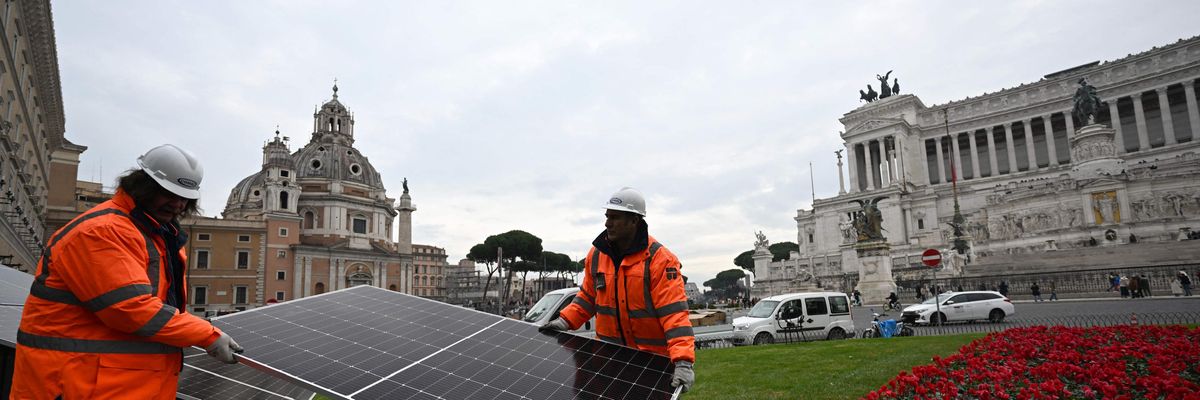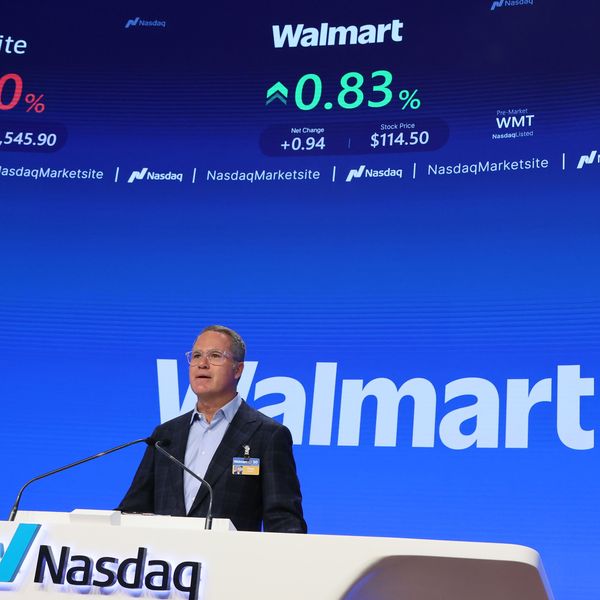
Workers install solar panels to power historical buildings and a Christmas tree in central Rome on December 2, 2022. (Photo: Filippo Monteforte/AFP via Getty Images)
Spurred by Russian Invasion of Ukraine, Solar Soars by 50% in EU: Report
"The numbers are clear. Solar is offering a lifeline amid energy and climate crises. No other energy source is growing as quickly or reliably as solar."
Driven significantly by dramatically reduced fossil fuel imports following Russia's invasion of Ukraine, solar production soared nearly 50% in the European Union this year--with even greater growth forecast for 2023, a report published this week by an industry group revealed.
"We're building a secure, green, prosperous Europe on a foundation of solar."
SolarPower Europe said in the introduction to a new report that "2022 was the year when solar power displayed its true potential for the very first time in the E.U., driven by record high energy prices and geopolitical tensions that largely improved its business case."
No longer encumbered by serious supply chain bottlenecks due to the Covid-19 pandemic, the 27 E.U. nations added 41.4 gigawatts (GW) of new solar photovoltaic (PV) capacity to their grids, a 47% increase over 2021. That's enough to power the equivalent of around 12.4 million homes.
"The numbers are clear. Solar is offering a lifeline amid energy and climate crises," SolarPower Europe CEO Walburga Hemetsberger said in a statement. "No other energy source is growing as quickly or reliably as solar. We're building a secure, green, prosperous Europe on a foundation of solar."
\u201cThe 2022 market was led by Germany, Spain and Poland(!). The Netherlands at #4 with 4 GW added, ahead of France with its meager 2.7 GW, not even growing in a year of sky-high electricity prices. Italy at the same low level, but tripling its market compared to 2021.\u201d— Kees van der Leun (@Kees van der Leun) 1671480082
Ten E.U. countries added at least 1 GW of solar power this year. Perennial leader Germany again paced the E.U. in PV installation, adding nearly 8 GW. Spain followed closely, adding 7.5 GW, or 55% more than in 2021. Poland (4.9 GW), the Netherlands (4.0 GW), and France (2.7 GW) rounded out the top five E.U. solar powers.
Russia's invasion of Ukraine, now approaching the 10-month mark, has spurred record growth of renewable energy in Europe. Not only has this accelerated the green energy transition amid the worsening climate emergency, it has also helped offset soaring gas costs.
Research published in October by think tanks E3G and Ember revealed that record European wind and solar production averted EUR11 billion ($11.7 billion) in extra gas costs since Russian troops invaded Ukraine on February 24.
"Wind and solar are already helping European citizens, but the future potential is even greater," Ember senior analyst Chris Rosslowe said at the time.
\u201cIn two scenarios, SolarPower Europe sees cumulative EU solar PV capacity double or triple by 2026, to 400-600 GW.\u201d— Kees van der Leun (@Kees van der Leun) 1671480082
According to the International Energy Agency--which last year stressed the necessity of swiftly shifting from fossil fuels to clean energy--E.U. countries must install approximately 60 GW of solar power next year to make up for gas shortfalls caused by the reduction of Russian supplies.
SolarPower Europe is "confident that further annual market growth will beat all expectations, exceed 50 GW deployment level in 2023, and more than double from today to 85 GW in 2026."
An Urgent Message From Our Co-Founder
Dear Common Dreams reader, The U.S. is on a fast track to authoritarianism like nothing I've ever seen. Meanwhile, corporate news outlets are utterly capitulating to Trump, twisting their coverage to avoid drawing his ire while lining up to stuff cash in his pockets. That's why I believe that Common Dreams is doing the best and most consequential reporting that we've ever done. Our small but mighty team is a progressive reporting powerhouse, covering the news every day that the corporate media never will. Our mission has always been simple: To inform. To inspire. And to ignite change for the common good. Now here's the key piece that I want all our readers to understand: None of this would be possible without your financial support. That's not just some fundraising cliche. It's the absolute and literal truth. We don't accept corporate advertising and never will. We don't have a paywall because we don't think people should be blocked from critical news based on their ability to pay. Everything we do is funded by the donations of readers like you. Will you donate now to help power the nonprofit, independent reporting of Common Dreams? Thank you for being a vital member of our community. Together, we can keep independent journalism alive when it’s needed most. - Craig Brown, Co-founder |
Driven significantly by dramatically reduced fossil fuel imports following Russia's invasion of Ukraine, solar production soared nearly 50% in the European Union this year--with even greater growth forecast for 2023, a report published this week by an industry group revealed.
"We're building a secure, green, prosperous Europe on a foundation of solar."
SolarPower Europe said in the introduction to a new report that "2022 was the year when solar power displayed its true potential for the very first time in the E.U., driven by record high energy prices and geopolitical tensions that largely improved its business case."
No longer encumbered by serious supply chain bottlenecks due to the Covid-19 pandemic, the 27 E.U. nations added 41.4 gigawatts (GW) of new solar photovoltaic (PV) capacity to their grids, a 47% increase over 2021. That's enough to power the equivalent of around 12.4 million homes.
"The numbers are clear. Solar is offering a lifeline amid energy and climate crises," SolarPower Europe CEO Walburga Hemetsberger said in a statement. "No other energy source is growing as quickly or reliably as solar. We're building a secure, green, prosperous Europe on a foundation of solar."
\u201cThe 2022 market was led by Germany, Spain and Poland(!). The Netherlands at #4 with 4 GW added, ahead of France with its meager 2.7 GW, not even growing in a year of sky-high electricity prices. Italy at the same low level, but tripling its market compared to 2021.\u201d— Kees van der Leun (@Kees van der Leun) 1671480082
Ten E.U. countries added at least 1 GW of solar power this year. Perennial leader Germany again paced the E.U. in PV installation, adding nearly 8 GW. Spain followed closely, adding 7.5 GW, or 55% more than in 2021. Poland (4.9 GW), the Netherlands (4.0 GW), and France (2.7 GW) rounded out the top five E.U. solar powers.
Russia's invasion of Ukraine, now approaching the 10-month mark, has spurred record growth of renewable energy in Europe. Not only has this accelerated the green energy transition amid the worsening climate emergency, it has also helped offset soaring gas costs.
Research published in October by think tanks E3G and Ember revealed that record European wind and solar production averted EUR11 billion ($11.7 billion) in extra gas costs since Russian troops invaded Ukraine on February 24.
"Wind and solar are already helping European citizens, but the future potential is even greater," Ember senior analyst Chris Rosslowe said at the time.
\u201cIn two scenarios, SolarPower Europe sees cumulative EU solar PV capacity double or triple by 2026, to 400-600 GW.\u201d— Kees van der Leun (@Kees van der Leun) 1671480082
According to the International Energy Agency--which last year stressed the necessity of swiftly shifting from fossil fuels to clean energy--E.U. countries must install approximately 60 GW of solar power next year to make up for gas shortfalls caused by the reduction of Russian supplies.
SolarPower Europe is "confident that further annual market growth will beat all expectations, exceed 50 GW deployment level in 2023, and more than double from today to 85 GW in 2026."
Driven significantly by dramatically reduced fossil fuel imports following Russia's invasion of Ukraine, solar production soared nearly 50% in the European Union this year--with even greater growth forecast for 2023, a report published this week by an industry group revealed.
"We're building a secure, green, prosperous Europe on a foundation of solar."
SolarPower Europe said in the introduction to a new report that "2022 was the year when solar power displayed its true potential for the very first time in the E.U., driven by record high energy prices and geopolitical tensions that largely improved its business case."
No longer encumbered by serious supply chain bottlenecks due to the Covid-19 pandemic, the 27 E.U. nations added 41.4 gigawatts (GW) of new solar photovoltaic (PV) capacity to their grids, a 47% increase over 2021. That's enough to power the equivalent of around 12.4 million homes.
"The numbers are clear. Solar is offering a lifeline amid energy and climate crises," SolarPower Europe CEO Walburga Hemetsberger said in a statement. "No other energy source is growing as quickly or reliably as solar. We're building a secure, green, prosperous Europe on a foundation of solar."
\u201cThe 2022 market was led by Germany, Spain and Poland(!). The Netherlands at #4 with 4 GW added, ahead of France with its meager 2.7 GW, not even growing in a year of sky-high electricity prices. Italy at the same low level, but tripling its market compared to 2021.\u201d— Kees van der Leun (@Kees van der Leun) 1671480082
Ten E.U. countries added at least 1 GW of solar power this year. Perennial leader Germany again paced the E.U. in PV installation, adding nearly 8 GW. Spain followed closely, adding 7.5 GW, or 55% more than in 2021. Poland (4.9 GW), the Netherlands (4.0 GW), and France (2.7 GW) rounded out the top five E.U. solar powers.
Russia's invasion of Ukraine, now approaching the 10-month mark, has spurred record growth of renewable energy in Europe. Not only has this accelerated the green energy transition amid the worsening climate emergency, it has also helped offset soaring gas costs.
Research published in October by think tanks E3G and Ember revealed that record European wind and solar production averted EUR11 billion ($11.7 billion) in extra gas costs since Russian troops invaded Ukraine on February 24.
"Wind and solar are already helping European citizens, but the future potential is even greater," Ember senior analyst Chris Rosslowe said at the time.
\u201cIn two scenarios, SolarPower Europe sees cumulative EU solar PV capacity double or triple by 2026, to 400-600 GW.\u201d— Kees van der Leun (@Kees van der Leun) 1671480082
According to the International Energy Agency--which last year stressed the necessity of swiftly shifting from fossil fuels to clean energy--E.U. countries must install approximately 60 GW of solar power next year to make up for gas shortfalls caused by the reduction of Russian supplies.
SolarPower Europe is "confident that further annual market growth will beat all expectations, exceed 50 GW deployment level in 2023, and more than double from today to 85 GW in 2026."

